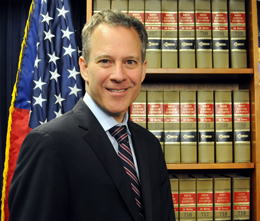 AG Schneiderman Leads 8 AGs in Suit Challenging EPA’s Refusal to Require Upwind States to Control Smog Pollution that Blows into New York and Northeast States
AG Schneiderman Leads 8 AGs in Suit Challenging EPA’s Refusal to Require Upwind States to Control Smog Pollution that Blows into New York and Northeast States
At Least One in Three New Yorkers Breathe Unhealthy Levels of Smog – Leading to Dire Health Issues
Attorney General Eric T. Schneiderman, leading a coalition of eight Attorneys General, filed a lawsuit today against the Trump Environmental Protection Agency (EPA) to force action under the Clean Air Act to ensure upwind states adequately control the pollution that blows into New York and other downwind states.
At least one in three New Yorkers breathe air with unhealthy levels of smog pollution, with some analyses placing it as high as two in three New Yorkers (approximately 12.7 million people). The EPA’s own studies demonstrate that pollution from states upwind of New York contributes substantially to the state’s harmful levels of smog.
“Millions of New Yorkers are breathing unhealthy air as smog pollution continues to pour in from other states,” Attorney General Schneiderman said. “The federal government has a fundamental responsibility to act. Yet the Trump EPA has abandoned its responsibilities – repeatedly failing to act to control smog pollution that jeopardizes New Yorkers’ health. Attorneys General will continue to act to protect those we serve.”
Specifically, the suit challenges the EPA’s denial of a petition that New York and several other states filed in late 2013 for the Agency to add nine additional states to the “Ozone Transport Region,” a group of states established under the federal Clean Air Act that must act in concert to reduce smog pollution within the region.
Joining Attorney General Schneiderman in the suit are the Attorneys General of Connecticut, Delaware, Maryland, Massachusetts, Pennsylvania, Rhode Island, and Vermont.
Reducing smog levels is vital to protecting the health of New Yorkers. Elevated levels of smog can cause a host of significant health effects, including coughing, throat irritation, lung tissue damage, and the aggravation of existing medical conditions, such as asthma, bronchitis, heart disease, and emphysema. According to the American Lung Association’s “2017 State of the Air Report,” the New York City metropolitan area ranks as the 9th most smog-polluted city in the nation.
Congress created the Ozone Transport Region to help states address pervasive smog problems in the northeastern United States. By statute, the Region consists of 11 states – Connecticut, Delaware, Maine, Maryland, Massachusetts, New Hampshire, New Jersey, New York, Pennsylvania, Rhode Island, Vermont – and the District of Columbia metropolitan area.
In December 2013, New York and other northeastern states submitted a petition under the Clean Air Act asking EPA to add nine additional states shown or projected through modelling and analysis to contribute to violations of federal smog standards in the Ozone Transport Region. These nine states are Illinois, Indiana, Kentucky, Michigan, North Carolina, Ohio, Tennessee, Virginia, and West Virginia. When EPA took no action on that petition, a coalition of states led by Attorney General Schneiderman filed suit against the EPA to compel it to act.Attorney General Schneiderman and the coalition of states subsequently negotiated a consent decree that required EPA to approve or disapprove the petition no later than October 27, 2017. On that date, Trump EPA Administrator Pruitt denied the states’ Ozone Transport Region petition.
Today’s suit, which was filed in the U.S. Court of Appeals for the District of Columbia Circuit, asks the court to review Administrator Pruitt’s denial of the petition. The coalition will ask the court to determine that the denial is unlawful and to vacate it.
Ozone Transport Region
Each state within the Ozone Transport Region must develop and implement plans that achieve controls on pollutants that contribute to the formation of smog. However, despite enacting stringent in-state controls on sources of these pollutants, many states within the Region – including New York – are not able to meet federal health-based air quality standards for smog, significantly due to upwind smog pollution.
Modeling and analysis performed by EPA, as well as by states, has shown that interstate transport of air pollution from upwind states outside of the Ozone Transport Region –including Illinois, Indiana, Kentucky, Michigan, Ohio, Tennessee, Virginia, and West Virginia – contributes significantly to violations of the 2008 federal smog standard within the Ozone Transport Region. In addition, preliminary modeling demonstrates that emissions in these states, as well as North Carolina, are projected to contribute to violations of the recently updated 2015 federal smog standard in the Region.
States outside and upwind of the Region are not required to – and generally do not – impose controls as stringent as those required of those within the Region. However, the federal Clean Air Act provides for states to petition EPA to add states to the Ozone Transport Region, and for EPA to add states when the Agency has reason to believe that the interstate transport of air pollution from them significantly contributes to exceedances of the federal standards for smog in the Region.
This matter is being handled for the Attorney General’s Environmental Protection Bureau by Assistant Attorney General Claiborne Walthall, Affirmative Section Chief Morgan A. Costello, and Senior Counsel Michael J. Myers. The Bureau is led by Bureau Chief Lemuel M. Srolovic and is part of the Division of Social Justice, which is led by Executive Deputy Attorney General for Social Justice Alvin Bragg.

